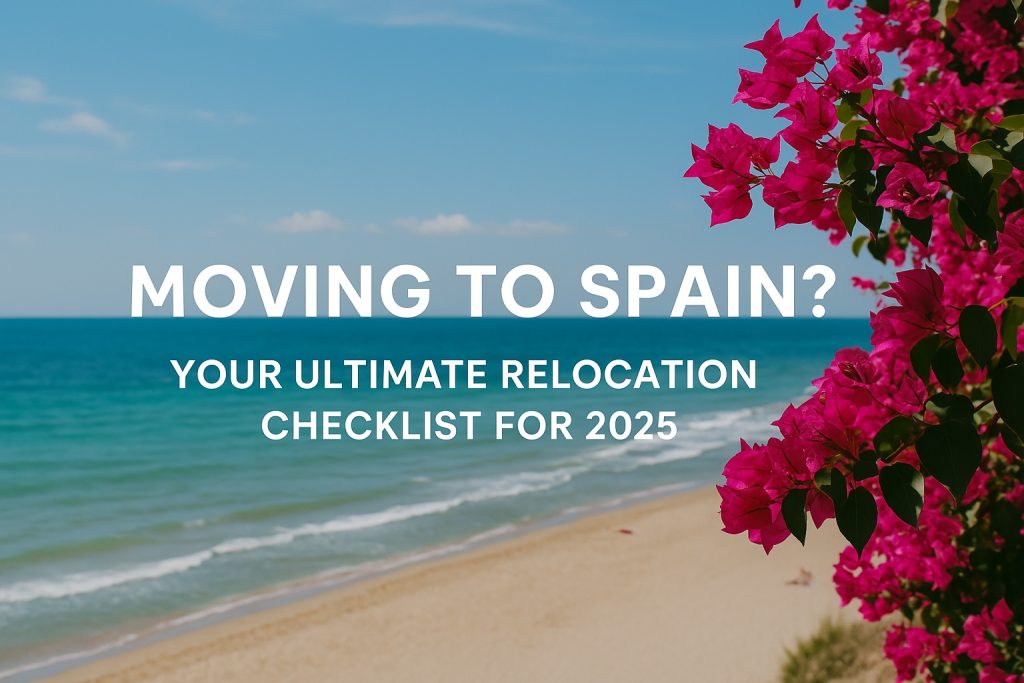
Table of Contents
Planning on moving to Spain from the US, Canada, or Europe? Use this step-by-step relocation checklist to prepare your move. Find out how Globexs can help with housing, paperwork, and settling in — starting with top expat cities like Valencia, Madrid, and Barcelona.
Step 1: Moving to Spain? Decide Where to Live
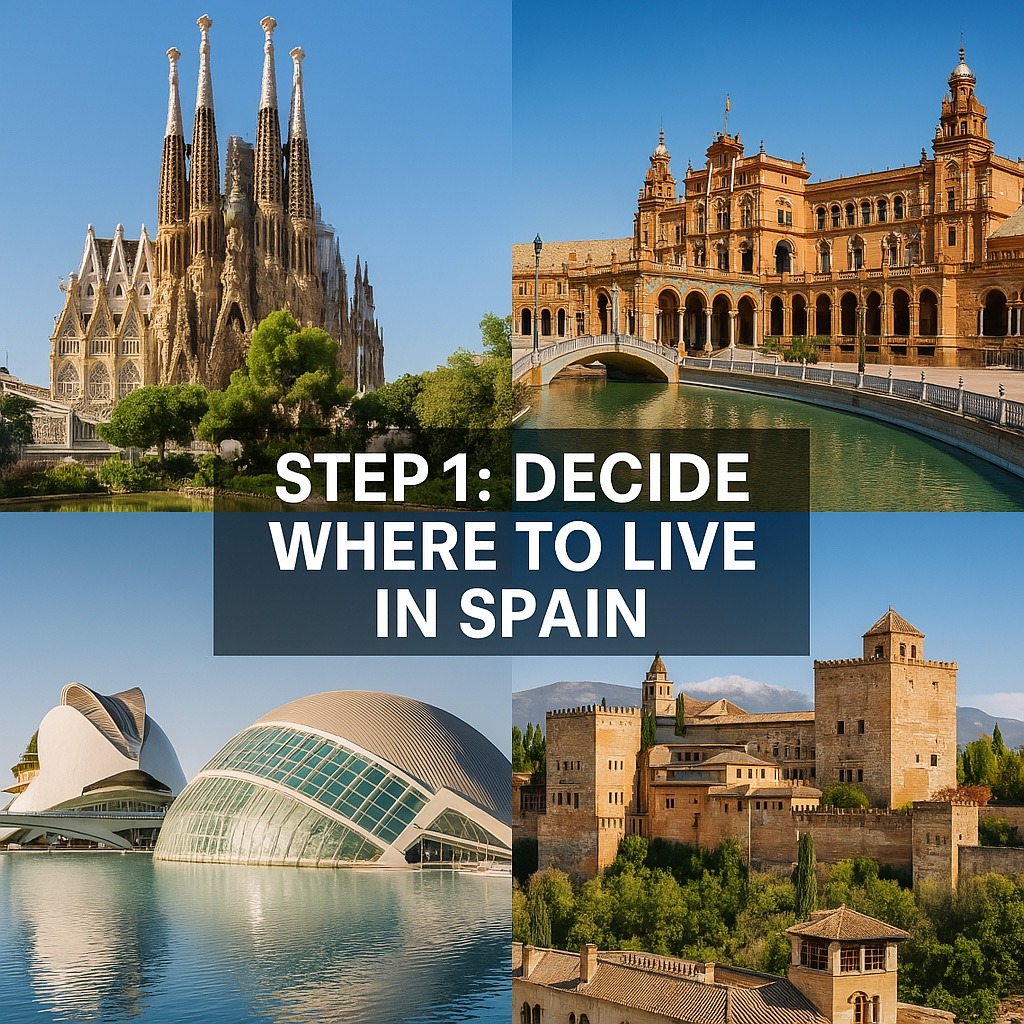
If you’re moving to Spain from the US, Canada, or elsewhere in Europe, one of the first steps is deciding where to live. Spain is wonderfully diverse, and choosing the right city can make all the difference in how smoothly you adapt and enjoy your new chapter.
Before anything else, let’s make one thing clear: relocating to Spain is much easier when you have a trusted partner by your side.
Globexs is a relocation company based in Valencia, and we help expats, remote workers, and digital nomads with housing, legal support, local guidance, and everything in between.
Valencia – Our home, and our #1 recommendation
Valencia offers the perfect mix of sunshine, sea, and city living, with a lower cost of living than Madrid or Barcelona. It’s ideal for families, digital nomads, and remote professionals who value both lifestyle and affordability. The pace is relaxed, the people are welcoming, and the infrastructure is modern.
Download our free Ultimate Guide to Move to Valencia, written by our founder Lodewijk Cuypers. It has already helped hundreds of expats settle in the city with ease.
Madrid – Spain’s capital of opportunities
Madrid is the heart of Spain’s business, government, and education sectors. If you’re looking for career opportunities, international schools, or want to be close to embassies and global companies, Madrid could be your ideal base. It's dynamic, diverse, and surprisingly livable for a major capital.
Barcelona – A creative hub by the sea
Barcelona is known for its cosmopolitan energy, art scene, and Mediterranean lifestyle. It’s popular with entrepreneurs, designers, and tech professionals who want to combine career growth with beachside living. The housing market is competitive, but the lifestyle is hard to beat.
So now it’s clear — you’ve chosen your city and sent us your request.
We’ll take care of the rest by finding the perfect home that fits your lifestyle and needs.
Don’t forget to fill out the contact form or
Browse available apartments in Spain
Decide Where to Live in Spain – done ✅ Once you’ve chosen your city, it’s time to move on to next step.
Step 2: Check Visa Requirements & Residency Options
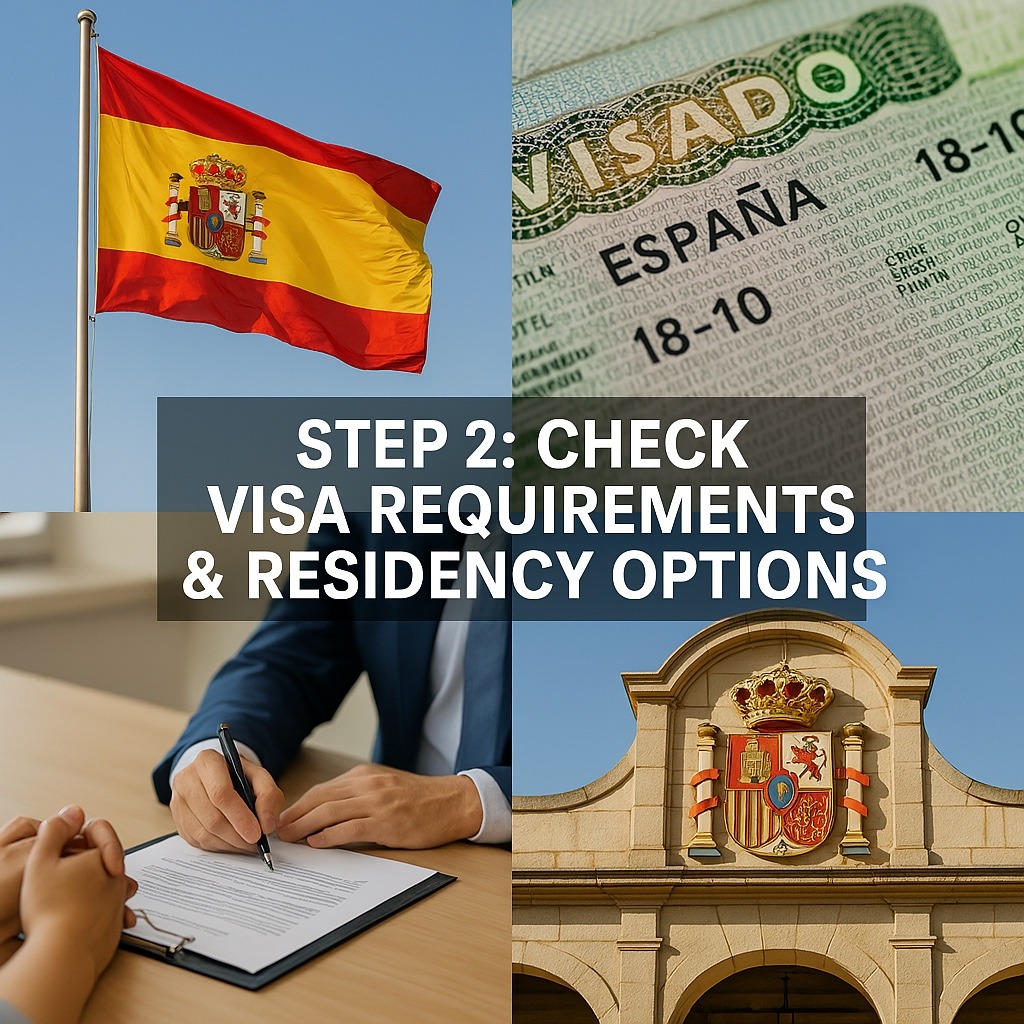
Moving to Spain? Before packing your bags for Spain, it’s essential to understand what kind of visa or residence permit you’ll need. Spain offers various immigration paths depending on your nationality, work status, income, and reason for moving.
EU/EEA/Swiss Citizens
Moving to Spain from the EU, EEA, or Switzerland? You don’t need a visa to live, work, or study in Spain. However, if you plan to stay longer than 90 days, you'll need to apply for a EU Residence Certificate.
Non-EU Citizens: Visa & Residency Options
Moving to Spain from the US? The Digital Nomad Visa Might Be for You
Digital Nomad Visa (Visado para teletrabajadores de carácter internacional)
Perfect for remote workers and freelancers, especially those moving to Spain from the US or other non-EU countries.
Digital Nomad Visa (Visado para teletrabajo de carácter internacional)
Perfect for remote workers and freelancers.
Work for a non-Spanish company
Show proof of income (approx €2,762/month minimum in 2025)
Valid for up to 1 year if you apply at your closest consulate or 3 years if you apply in spain.
This visa has become one of the top choices for Globexs clients relocating to Spain with flexible lifestyles.
Non-Lucrative Visa
Ideal for retirees or individuals with passive income.
No work allowed in Spain
Requires proof of stable monthly income (approx. €2,400/month in 2025)
Initial residency for 1 year, renewable
A good option if you're not planning to work but want to live or invest in Spain long-term.
Work Visa (Employment or Self-employed)
You’ll need a job offer from a Spanish employer or a self-employment plan approved by authorities.
Paperwork is typically started by the employer or via a lawyer
Good for long-term professional relocation
Note: These visas can take time to process and require more legal steps.
Student Visa
If you’re planning to study in Spain for more than 90 days.
Allows part-time work (depending of the type of course you apply for).
Requires enrollment in an approved course by the education authorities
Can sometimes be converted into a work visa later
What About the Golden Visa?
Moving to Spain through investment? Spain officially scrapped the Golden Visa program in 2024.
Previously, this scheme allowed foreigners to gain residency by investing at least €500,000 in Spanish property.
As of 2025, this is no longer an option. If you're considering real estate investment, you'll still need a separate visa — owning property alone won’t give you residency rights anymore.
Useful Tips:
-
Always check the latest requirements on the official Spanish consulate website or talk to a relocation expert.
-
Globexs offers full legal support through a dedicated team of immigration lawyers specialized in relocation to Spain.
From helping you choose the right visa type, to submitting paperwork, translating documents, and even assisting with NIE numbers and local registrations – our team is here to make your move as smooth as possible.
Whether you're a digital nomad, retiree, or entrepreneur, our comprehensive legal support ensures you stay compliant and confident throughout your relocation journey.
Check Visa Requirements & Residency Options – done ✅ Now that you’ve figured out your visa options, it’s time to move on to the next step.
Step 3: Organize important documents before moving to Spain
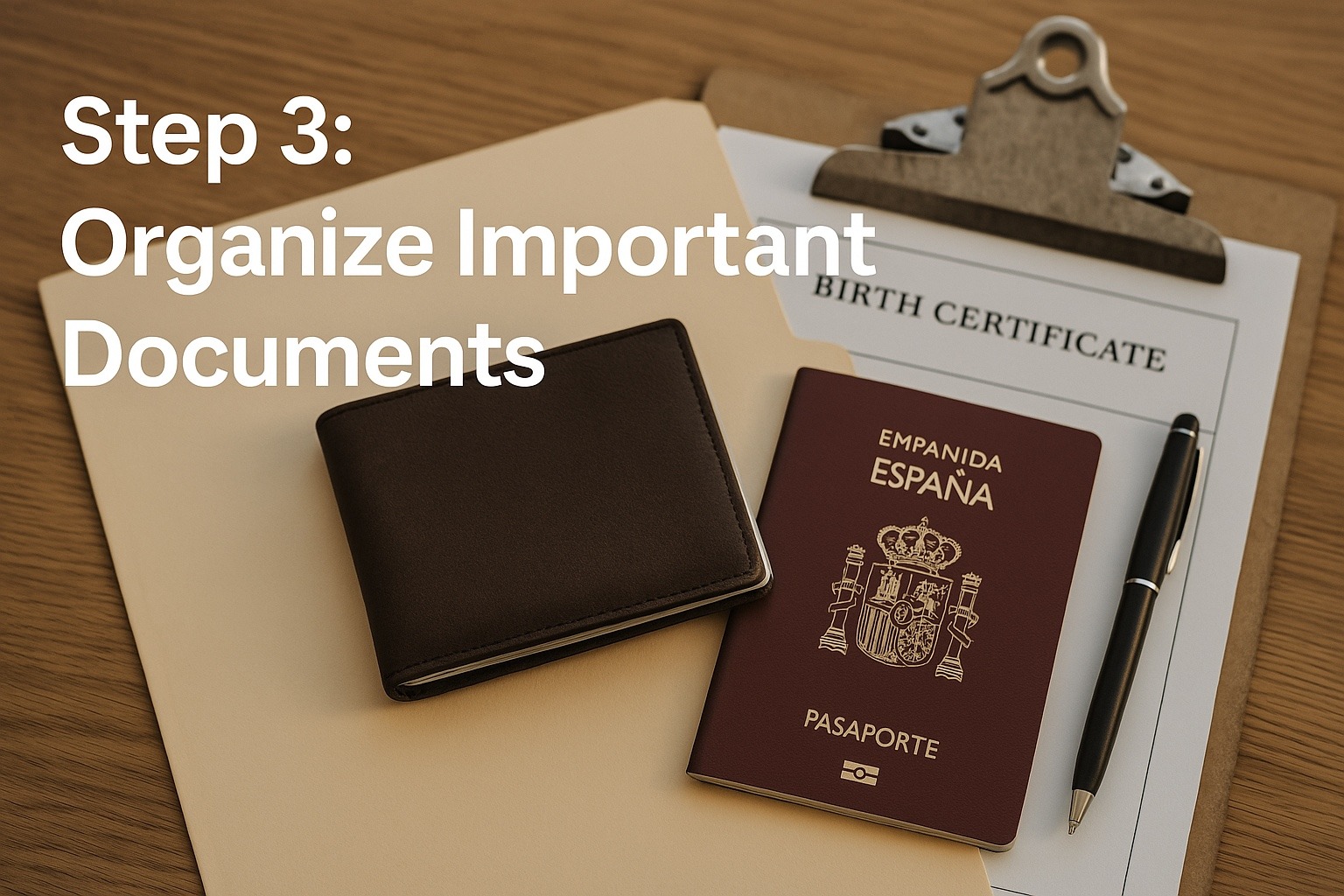
Once you’ve chosen your visa path, it’s time to get your paperwork in order. Spanish bureaucracy can be complex, and missing even one document can delay your application. So let’s make sure you have everything ready.
Key Documents You May Need
Personal Identification
-
Valid passport (at least 6–12 months of validity)
-
Passport-sized photos (Spanish format, white background)
-
Birth certificate (especially for children or family applications)
Visa & Residency Documents
-
Completed visa application form
-
Proof of income or employment (e.g. payslips, work contracts, pension statements)
-
Criminal background check (from your country, issued within the past 90 days)
-
Medical certificate (stating you’re free from contagious diseases)
-
Proof of address
-
Health insurance (required for most visa types)
Supporting Documents (if applicable)
-
Marriage certificate
-
School enrollment confirmation (for children)
-
University acceptance letter (for student visas)
-
Proof of remote work (for digital nomad visa applicants)
Translation & Legalization
Many documents must be:
-
Officially translated into Spanish by a sworn translator (traductor jurado)
-
Legalized or apostilled (especially documents issued outside the EU)
✅ At Globexs, our legal team can help you coordinate certified translations and legalization of all necessary paperwork.
Pro Tip:
Start early! Some documents (like background checks or apostilles) can take several weeks. We recommend letting our legal experts at Globexs review your documents before submission to avoid surprises.
Let Globexs Handle the Paperwork
Our team of immigration lawyers specializes in Spanish immigration procedures and can support you. We simplify the process — so you can focus on your new life in Spain.
Organize Important Documents – done ✅ With your paperwork ready, you’re one big step closer to Spain. Now it’s time to prepare your finances for the move.
Step 4: Plan Your Finances

Moving to Spain isn’t just about packing your bags — it’s also about being financially prepared. Whether you're relocating mid-term or settling down for good, getting your finances in order will help you avoid surprises and feel secure from day one. If you’re moving to Spain from the US, understanding the local cost of living, currency exchange, and banking system becomes especially important.
Set a Monthly Budget
Start by estimating your monthly cost of living in Spain. This can vary widely depending on the city and your lifestyle.
Here’s a rough idea for 2025:
Rent (1-bedroom, furnished) €800 – €1,300+ (city-dependent)
Utilities & Internet €100 – €180
Groceries €250 – €400
Health Insurance €50 – €150
Transportation (public) €40 – €60
Dining out / Leisure €100 – €300
💡Living in Valencia, Seville, or Málaga can be much more affordable than Madrid or Barcelona.
Open a Spanish Bank Account
Once in Spain, you’ll likely need a local bank account — especially if you’re renting long-term, paying bills, or receiving income locally.
You’ll need:
-
Passport
-
NIE number
-
Proof of address
-
Sometimes a rental contract or utility bill
Globexs partners can assist you with opening a bank account and explain the difference between resident and non-resident accounts.
Understand Currency Transfers & Banking Fees
If your income is in a foreign currency, look into currency exchange services or multi-currency accounts (e.g., Wise, Revolut) to avoid high bank fees.
Don’t Forget About Taxes
If you spend more than 183 days per year in Spain, you may be considered a tax resident and must declare your global income.
Globexs works with trusted tax advisors who help expats and digital nomads stay compliant with Spanish tax law.
Step 4: Plan Your Finances – done ✅ Your financial groundwork is ready! Now it’s time to find your home in Spain.
Step 5: Moving to Spain? Look for Accommodation
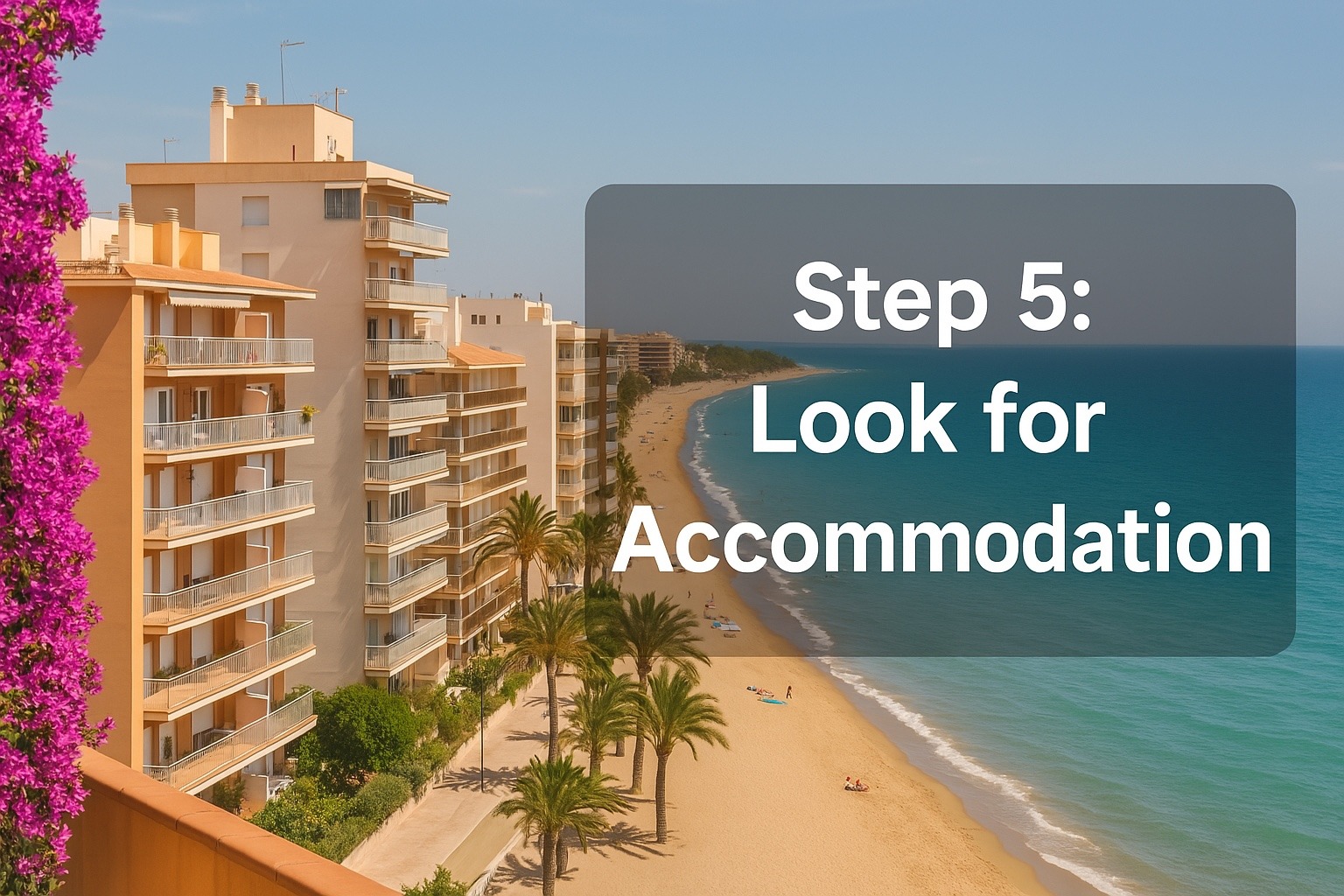
Finding a place to live in Spain is one of the most exciting (and sometimes stressful) parts of your relocation journey. Whether you're staying for a few months or settling long-term, you’ll want to choose a rental that fits your lifestyle, legal requirements, and budget.
Short-Term vs. Long-Term Rentals
Short/Mid-term (1–11 months)
Ideal for digital nomads, remote workers, or people who are still exploring cities before committing.
-
Fully furnished
-
Flexible lease terms
-
Utilities often included
-
Registration (empadronamiento) may or may not be possible
Long-term (12+ months)
Better for families, remote workers with stable plans, or those applying for residency.
-
Usually more affordable per month
-
Often unfurnished or semi-furnished
-
Empadronamiento is typically allowed
-
More legal paperwork (rental contract, bank deposits, etc.)
What is Flex Living?
At Globexs, we offer more than just a place to stay — we offer Flex Living.
Flex Living is the ideal solution for expats, remote professionals, and retirees who want freedom and community while exploring life in Spain.
Here’s how it works:
-
You rent a private room in a shared, fully equipped apartment.
-
You join a community of like-minded people — digital nomads, professionals, and international residents.
-
Stay for 1 month, 2 months, or longer in one city (e.g., Madrid), and if you want a change of scenery, you can move to another Globexs apartment in a different city (like Valencia) — under the same contract.
-
No hassle, no new agreements — just flexibility and support.
✅ One contract. Multiple cities. Full freedom.
This is smart, community-driven living for a new kind of expat lifestyle.
Important Tip: Not All Rentals Allow Registration
If you need to register your address (empadronamiento) for immigration purposes, make sure the landlord allows it.
What to Expect from Spanish Apartments
-
Elevators are not guaranteed, especially in older buildings
-
Heating is rare in coastal areas – consider this if moving in winter
-
Air conditioning is a big plus during summer
-
Community fees may be included in rent (ask in advance)
How Globexs Can Help
We offer a curated selection of legal, fully furnished rentals across Spain – perfect for digital nomads, remote workers, and relocating families.
With Globexs, you benefit from:
✔ Flexible rental contracts (1 to 11 months)
✔ Fully furnished apartments with all utilities included
✔ Prime locations in major European cities
✔ Corporate housing solutions tailored for business professionals
✔ Hassle-free rental process with no hidden fees
Step 5: Look for Accommodation – done ✅ You’ve found your home in Spain — now let’s make sure your healthcare is covered.
Step 6: Arrange Health Insurance

Whether you're staying in Spain for a few months or settling down long-term, health insurance is a non-negotiable requirement — especially if you’re applying for a visa or residency permit.
Do I Need Health Insurance in Spain?
Yes — if you're a non-EU citizen applying for any type of visa (digital nomad, non-lucrative, student, etc.), you are required to show proof of private health insurance that meets strict criteria:
-
Must provide full coverage in Spain
-
No co-payments (sin copago)
-
Must be from a company authorized to operate in Spain
-
Minimum duration: one year
Public vs. Private Healthcare
Public Healthcare
If you become a legal resident and start contributing to Spanish social security (e.g., as an employee or self-employed worker), you can access Spain's excellent public healthcare system.
But this doesn’t apply until after you’ve registered and started working — which is why most newcomers need private coverage first.
Private Healthcare
Private health insurance gives you:
-
Faster appointments and shorter waiting times
-
Access to English-speaking doctors and clinics
-
Peace of mind during the immigration process
Plans typically start around €40–€100/month, depending on age and coverage level.
Choose the Right Policy for Your Visa
Not all private policies are accepted by immigration offices. Make sure your insurance:
-
Is issued by a recognized provider in Spain
-
Includes hospitalization and general medical coverage
-
Covers the full length of your intended stay
Step 6: Arrange Health Insurance – done ✅ You're now covered — in every sense!
Step 7: Set Up Utilities and Internet
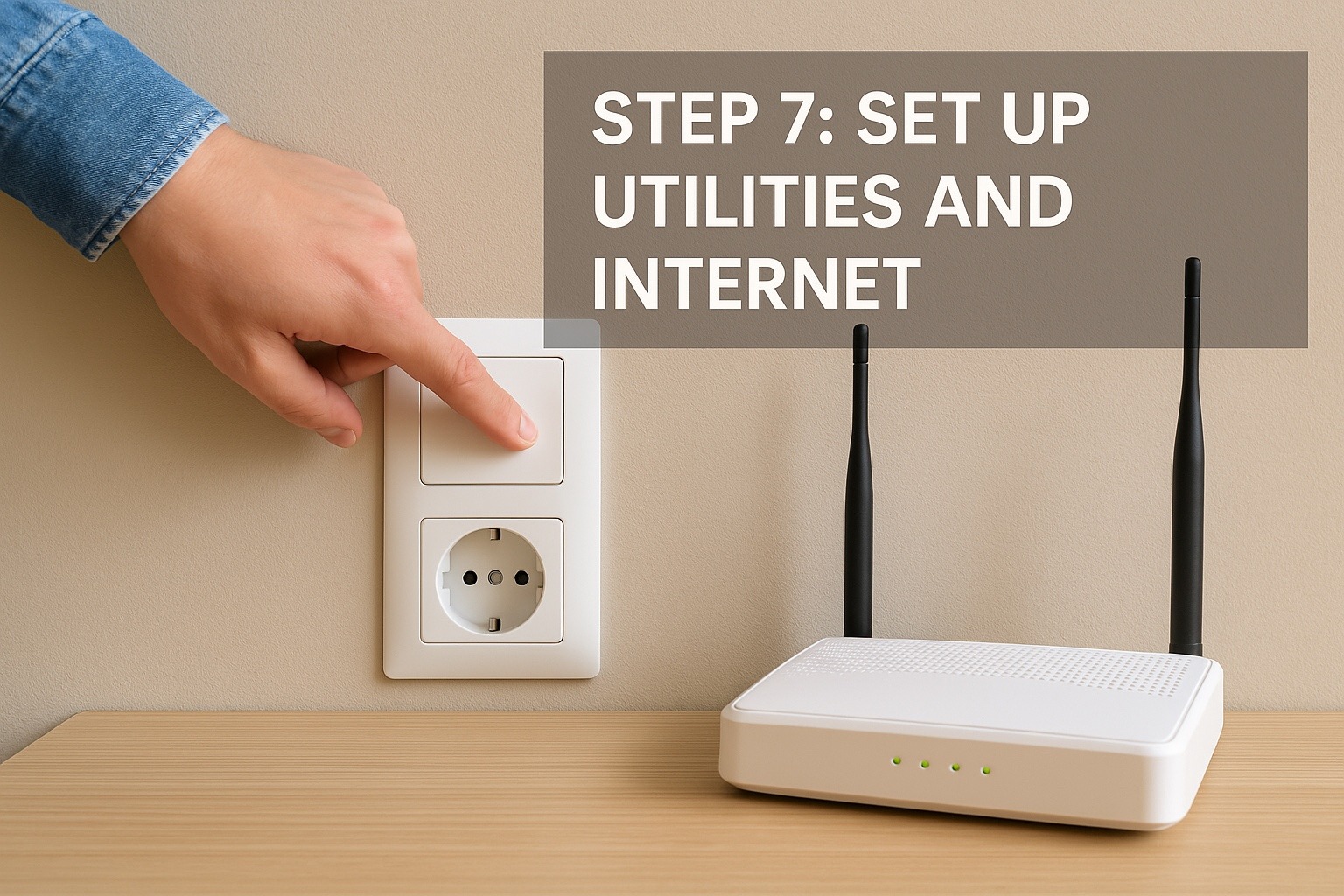
If you’re renting a fully furnished apartment with bills included, you can skip this step — and with Globexs rentals, that’s often the case.
But if you're renting a long-term flat without utilities included, or if you've purchased a property in Spain, you'll need to set up water, electricity, gas, and internet yourself.
Here’s how the process works.
Electricity (Electricidad)
Most homes in Spain are powered by the national electricity grid. You can either take over an existing contract or start a new one if the property is empty.
Major providers:
-
Iberdrola – www.iberdrola.es
-
Endesa – www.endesa.com
-
Naturgy – www.naturgy.es
-
Repsol – www.repsol.com
Average monthly cost: €50–€100 depending on consumption, size of home, and time-of-use tariff.
Gas (Gas Natural)
Many urban apartments use natural gas for hot water or heating. In some cases, gas is bottled (especially in rural areas).
Gas suppliers:
-
Same providers as electricity: Iberdrola, Endesa, Naturgy, Repsol
-
Also check local gas installers (especially for bottled gas – “butano”)
Average monthly cost: €30–€60
Water (Agua)
Water is managed locally by each city’s municipal provider, not private companies.
You’ll usually need to:
-
Provide your NIE
-
Submit a utility bill and rental contract
-
Schedule a meter reading or connection
Examples of city providers:
-
Emivasa (Valencia) – www.emivasa.es
-
Canal Isabel II (Madrid) – www.canaldeisabelsegunda.es
-
Agbar (Barcelona) – www.agbar.es
Average monthly cost: €20–€40
Internet and Mobile
Spain offers high-speed internet (up to 1Gbps in cities) and good 4G/5G coverage.
Major providers:
-
Movistar – www.movistar.es
-
Vodafone – www.vodafone.es
-
Orange – www.orange.es
-
MásMóvil / Yoigo – www.masmovil.es
Internet packages: €30–€60/month
Mobile plans: €10–€30/month (data included)
To sign up, you'll usually need:
-
NIE number
-
Spanish bank account
-
Proof of address (rental contract or utility bill)
Prefer a Hands-Off Approach?
At Globexs, we offer an all-in-one rental solution:
✔ Utilities
✔ Internet
✔ Furniture
✔ Legal rental contracts
✔ Empadronamiento-friendly properties
So if you’re renting with Globexs, you can skip this step completely. We’ve got it all covered.
Step 7: Set Up Utilities and Internet – done ✅ With your home connected and online, you're ready to handle practical daily life in Spain.
Step 8: Moving to Spain? Open a Spanish Bank Account
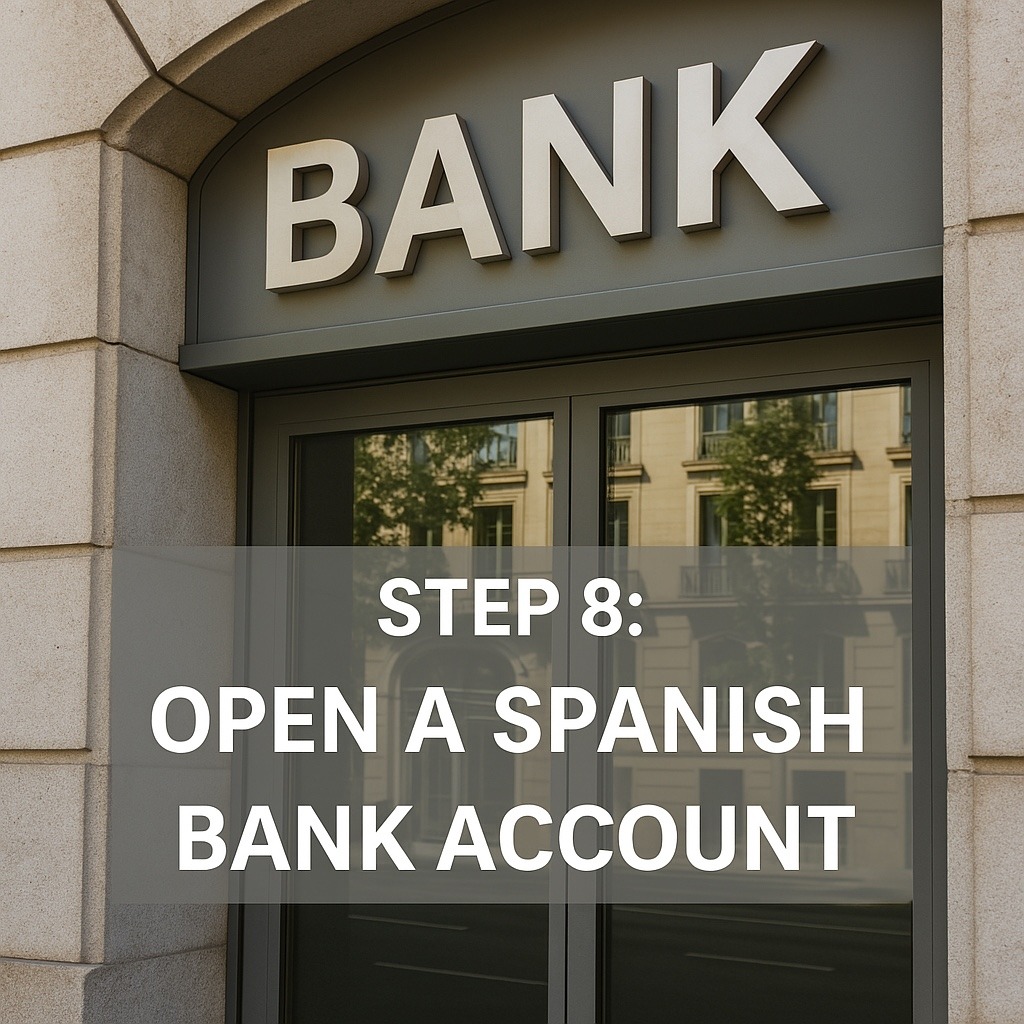
If you plan to stay in Spain for more than a few weeks — especially if you're renting long-term, applying for residency, or setting up utilities — opening a Spanish bank account will make your life much easier.
Why You Need a Spanish Bank Account
Having a local account helps you:
-
Pay rent and utility bills
-
Receive income (if working or invoicing in Spain)
-
Set up direct debits (for mobile, internet, etc.)
-
Avoid international transfer fees
💡 Some landlords, insurance providers, and even immigration offices may require a Spanish bank accountfor documentation.
What You Need to Open One
Requirements can vary by bank and region, but generally you’ll need:
-
Valid passport or national ID
-
NIE number (Número de Identificación de Extranjero)
-
Proof of address in Spain (e.g. rental contract)
-
Proof of income or employment (sometimes requested)
-
Tax identification number from your home country (NIF)
If you're still waiting for your residency or NIE, some banks also offer non-resident accounts.
Top Banks in Spain
Traditional Banks:
-
CaixaBank – www.caixabank.es
-
Banco Santander – www.bancosantander.es
-
BBVA – www.bbva.es
-
Sabadell – www.bancsabadell.com
Online / Fintech Banks:
-
N26 – www.n26.com
-
Revolut – www.revolut.com
-
Wise (TransferWise) – www.wise.com
Note: Not all online banks are accepted for official paperwork (e.g., visa, empadronamiento).
Need Help?
The Globexs team can guide you through the process of opening a bank account.
Step 8: Open a Spanish Bank Account – done ✅ Your financial foundation in Spain is set! Now let’s talk about one of your most powerful relocation tools: language.
Step 9: Learn Basic Spanish
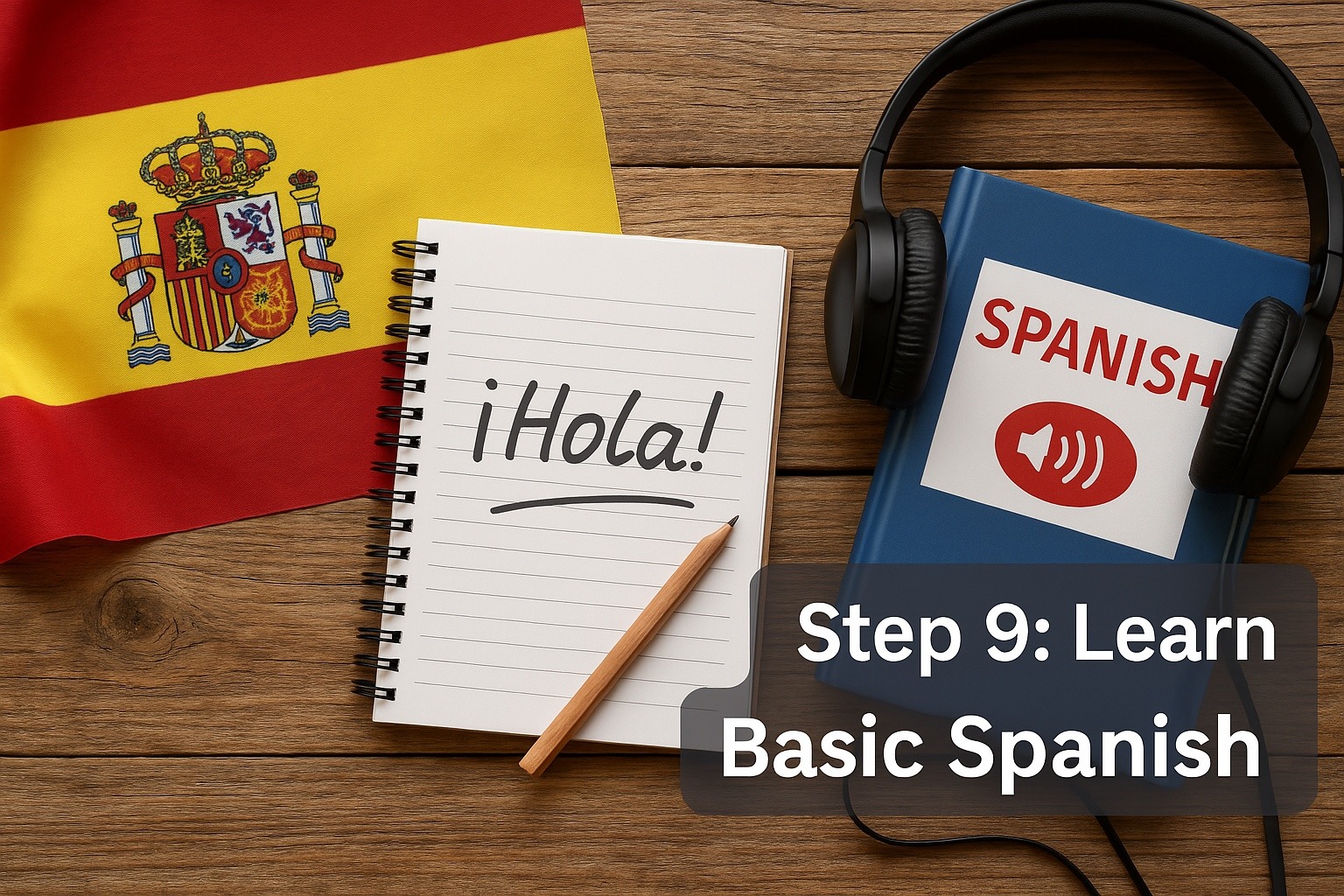
While many Spaniards in major cities speak some English — especially in tourist areas — daily life becomes much easier and more enjoyable when you speak a bit of Spanish. Even basic communication can go a long way in building connections, solving problems, and feeling at home.
By the way, here’s a great tip:
If you're part of the Globexs community, you’ll enjoy a range of exclusive benefits — including free access to Spanish language lessons to help you settle in faster.
Why Learning Spanish Matters
-
Helps you navigate local services (banks, healthcare, transport)
-
Makes bureaucracy less intimidating
-
Shows respect to the culture and people
-
Helps you connect with neighbors, shop owners, and locals
-
Boosts your chances of employment or integration long-term
🇪🇸 Even knowing how to say “hola,” “gracias,” and “¿puedes ayudarme?” can make a big difference in everyday life.
How to Get Started
Language Apps:
-
Duolingo – gamified and fun
-
Babbel – focused on practical conversation
-
LingQ – great for listening and vocabulary
-
Italki / Preply – connect with real teachers for 1-on-1 online lessons
Local Language Schools (in-person)
In most cities, you’ll find Spanish language academies offering group or private classes.
You can even join city-run free or low-cost courses for new residents.
Community Practice:
-
Join local language exchanges (intercambios)
-
Attend events, meetups, or co-working spaces where Spanish is spoken
-
Practice with Spanish roommates or neighbors if you're in a Flex Living apartment
Focus on Everyday Phrases
Start with:
-
Greetings and introductions
-
Asking for help
-
Shopping and restaurants
-
Directions and transportation
-
Basic bureaucracy terms (e.g. cita previa, empadronamiento, factura)
💡 Be sure to check out the Globexs Community page to see what other bonuses you have access to — free Spanish lessons are just the beginning!
This makes communication easy and helps clients from different backgrounds feel comfortable and supported throughout the relocation process. Step 9: Learn Basic Spanish – done ✅ You’re now ready to interact, connect, and thrive in your new environment.
Step 10: Get a Local SIM Card
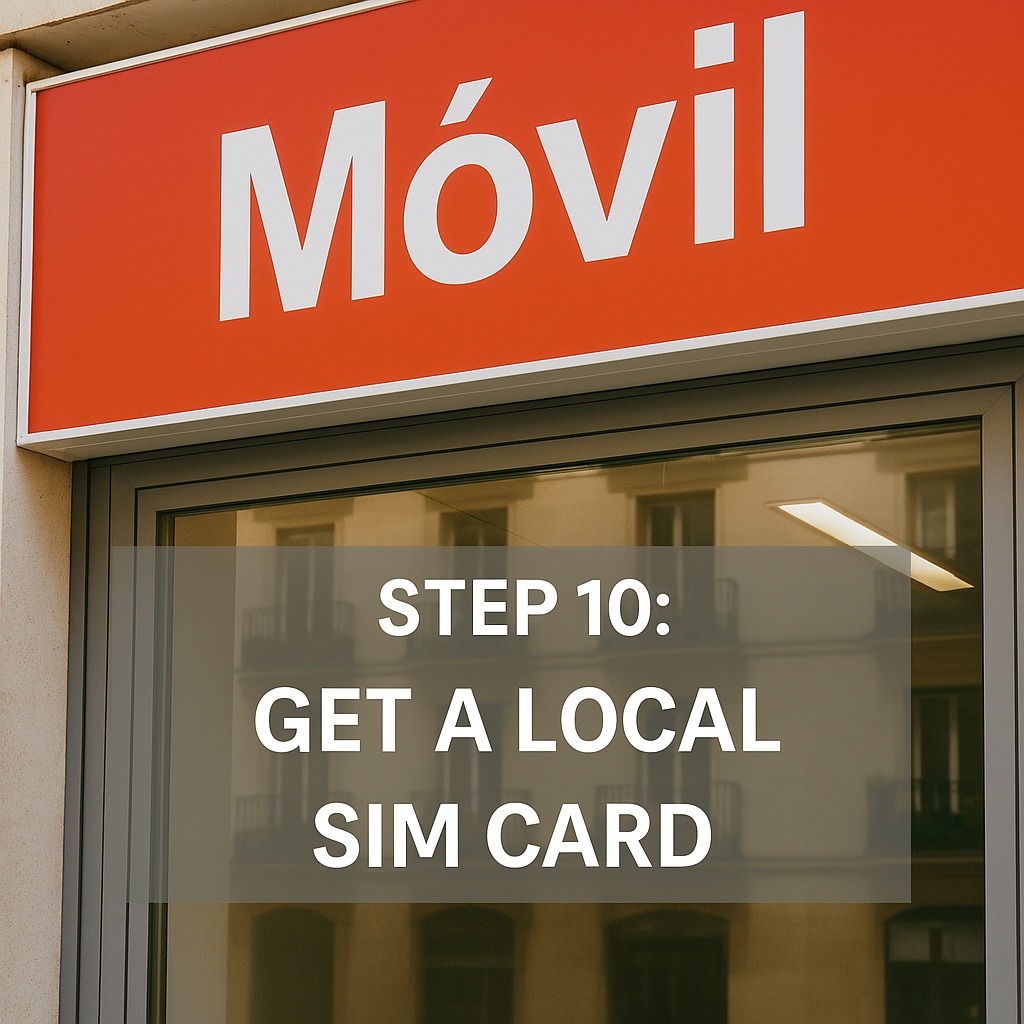
Having a Spanish phone number is essential for everyday life — from opening a bank account to receiving NIE appointment confirmations and accessing local services.
Why You Need a Local SIM When Moving to Spain
-
Required for many online registrations (government sites, banks, deliveries)
-
Helps avoid roaming charges
-
Essential for using public service apps, WhatsApp with locals, mobile banking, and more
-
Often requested when signing rental agreements, utilities, or health insurance
Prepaid vs. Contract
Prepaid (Prepago):
-
No paperwork required
-
Great for short stays or tourists
-
Recharge online or in shops
-
Can be set up with just a passport
Contract (Contrato):
-
Better long-term value
-
Often includes data + calls + fiber internet deals
-
Requires:
-
NIE number
-
Spanish bank account
-
Proof of address
-
Major Mobile Providers in Spain
Top national coverage Movistar
Good data plans Vodafone
Often bundles mobile + fiber Orange
Popular with expats Yoigo
Simple prepaid & flexible plans Lowi, Simyo, Pepephone
You can buy SIMs at physical stores, airports, tech shops like MediaMarkt, or order online with passport upload.
Globexs Tip
Many of our clients start with a prepaid SIM upon arrival, then switch to a full plan once their NIE and bank account are ready.
If you’re staying in a Globexs Flex Living apartment, roommates or hosts can often share local insights on the best providers in the area.
Step 10: Get a Local SIM Card – done ✅ Now you’re connected — ready to book appointments, stay in touch, and live like a local.
Step 11: Understand Transportation Options When Moving to Spain
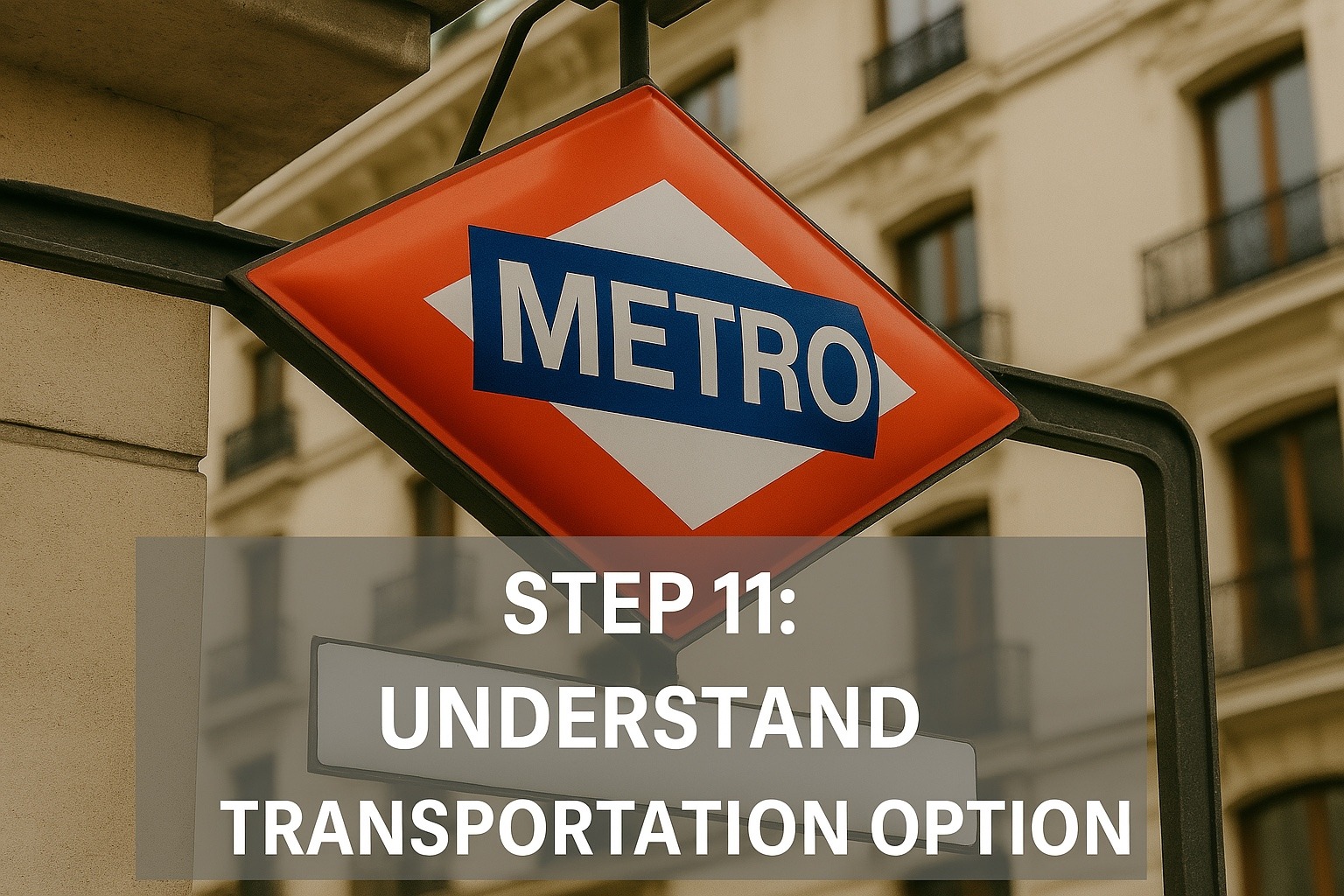
Getting around in Spain is easy, affordable, and efficient — whether you’re staying in a big city or planning weekend trips across the country.
Public Transportation in Cities
Major cities like Madrid, Barcelona, Valencia, and Seville have excellent public transport networks:
-
Metro / Subway – Fastest way to move across big cities
-
Buses – Widely available, including night routes
-
Trams – Common in cities like Valencia, Zaragoza, and Alicante
-
Suburban trains (Cercanías) – Great for commuting to/from suburbs
Most cities use rechargeable transport cards (e.g., Abono in Madrid, TuiN in Valencia) that can be topped up monthly or per trip.
Monthly pass cost: €20–€55, depending on zones and age.
Intercity & Regional Travel
Spain’s national rail network (Renfe) offers:
-
High-speed trains (AVE) – Fast and comfortable for long distances (e.g. Madrid–Barcelona in ~2.5 hrs)
-
Media Distancia / Regional Express – Slower, cheaper trains for regional travel
Tickets: www.renfe.com
Tip: Book early for AVE trains to get cheaper fares!
Car Rental & Driving
If you plan to explore smaller towns or rural areas, renting a car might be useful.
-
Spain drives on the right-hand side
-
EU licenses are accepted
-
Non-EU licenses may require an International Driving Permit (IDP)
Parking can be tricky in cities — many expats rely on public transport or car-sharing services instead.
Bike & Scooter Sharing
Cities like Valencia, Barcelona, and Madrid have excellent bike paths and eco-friendly options:
- Rent a bike or an e-scooter (Valencia) – www.bikealao.com
- Valenbisi (Valencia) – www.valenbisi.es
-
Bicing (Barcelona) – www.bicing.barcelona
-
Electric scooters from apps like Lime, Bird, or Tier
Domestic Flights
For longer trips (e.g. to the Canary Islands), domestic airlines like Iberia, Vueling, and Ryanair offer low-cost options.
Step 11: Understand Transportation Options – done ✅ Now you’re ready to explore the city — or the whole country — like a local.
Step 12: Explore Spanish Culture & Local Customs

Moving to Spain isn’t just about logistics — it’s about embracing a new lifestyle. The more you understand and enjoy Spanish culture, the more fulfilling your relocation experience will be.
Embrace the Spanish Way of Life
Spain is known for its relaxed pace, vibrant traditions, and strong community spirit. Here are a few things to keep in mind:
Time & Daily Rhythm
-
Lunch: 2–3 PM | Dinner: 9–10 PM
-
Many businesses close during siesta hours (around 2–5 PM), especially in smaller towns
-
Social life often happens late — don’t be surprised by 10 PM dinner invites!
Greetings & Formalities
-
A kiss on each cheek (dos besos) is a common greeting, even in semi-formal settings
-
Use “usted” for formal situations, and “tú” with friends or peers
-
Being polite and friendly is always appreciated — even a simple “buenos días” can go a long way
Dive Into Local Traditions
Every region has its own festivals, foods, and customs — from Fallas in Valencia to Feria in Seville.
Don’t miss:
-
Tapas nights
-
Weekly markets (mercadillos)
-
Local holidays (many shops close!)
-
Regional dishes — paella isn’t the same everywhere
At Globexs, we believe relocation is not just a move — it’s a cultural adventure.
Respect Cultural Differences
Moving to Spain? Then you’ll quickly notice that culture, habits, and communication styles may be different from what you're used to — and that’s part of the beauty.
-
Spain is diverse — with different co-official languages (Catalan, Basque, Galician) and strong regional identities
-
Bureaucracy may feel slow — but things usually get done eventually
-
Punctuality is flexible in social settings, but more expected for formal appointments
Step 12: Explore Spanish Culture & Local Customs – done ✅ You’re not just living in Spain — you’re living like a Spaniard. Now let’s take a look at what to do if you’re moving with your family.
Step 13: Enroll Children in School (for families)

If you're relocating with kids, Spain offers both public and private education options — including international schools for expat families.
School Options:
-
Public schools – Free, Spanish-speaking, and available to legal residents
-
Concertado schools – Semi-private, partly subsidized by the government
-
Private/International schools – Tuition-based, often bilingual or English-speaking
What You’ll Need:
-
NIE number (for parent and child)
-
Proof of address (empadronamiento)
-
Child’s birth certificate and immunization records
-
School application forms
💡 Most schools operate on a September–June calendar. Enrollment typically opens in spring.
If you're staying temporarily, international schools offer flexible admissions and multilingual education.
Step 13: Enroll Children in School – done ✅ With your child’s education sorted, let’s focus on the next big step: your career.
Step 14: How to Find Work in Spain
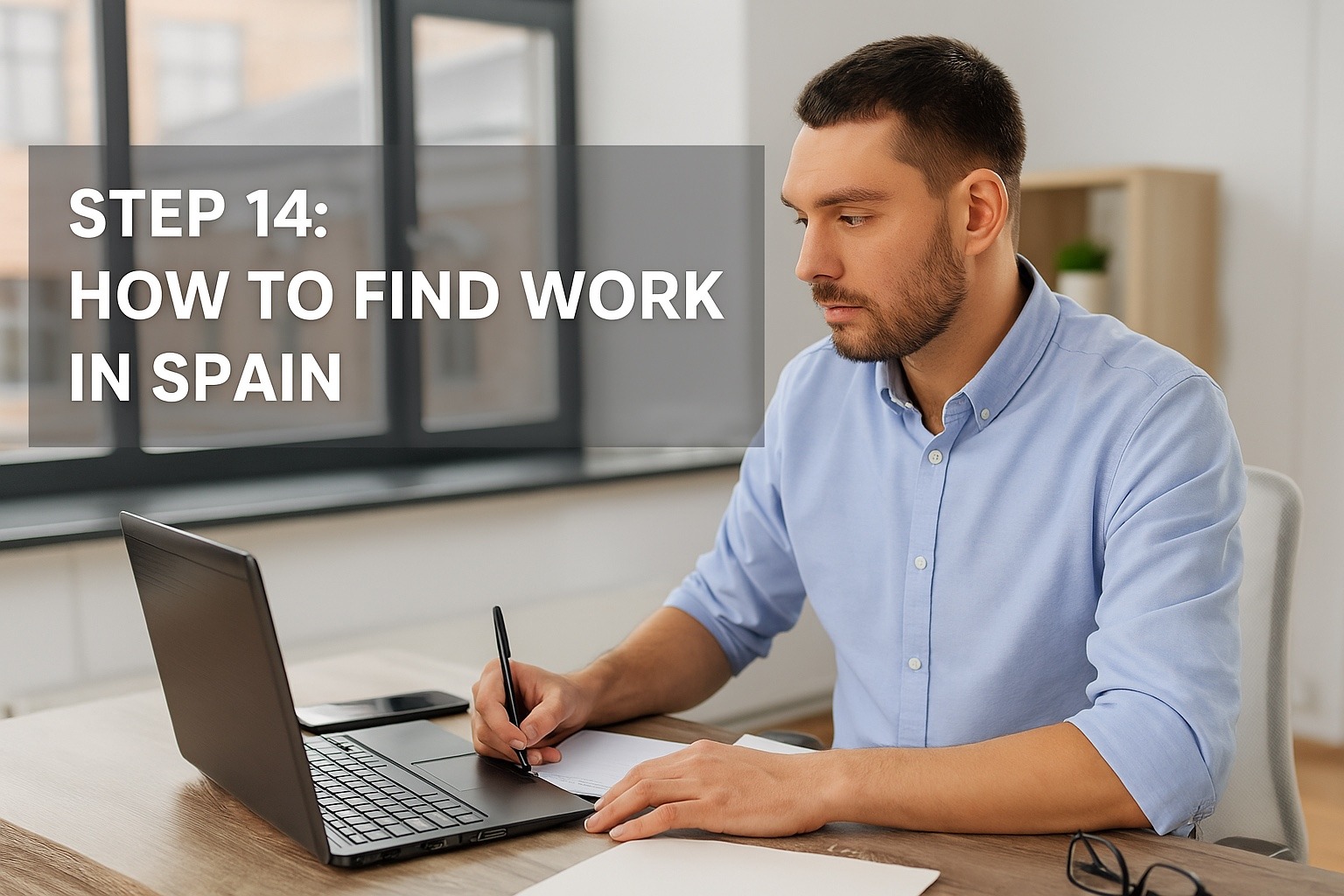
If you're not coming with a job already in hand, there are plenty of ways to build your career in Spain — whether you're an employee or a freelancer.
Options for Working in Spain
As an Employee:
Search through:
-
Job portals: InfoJobs, LinkedIn, Indeed España
-
International companies based in Spain
-
Recruiters in tech, tourism, teaching, and customer service
-
Coworking hubs with hiring boards
✅ Minimum wage in Spain (SMI) in 2025: approx. €1,134/month (gross) for full-time work (14 payments per year).
As a Freelancer (Autónomo):
Many Globexs clients are remote workers or digital freelancers. In Spain, that means registering as an autónomo (self-employed).
Moving to Spain as a Freelancer? Here's What You Need to Become an Autónomo
To register:
-
NIE number
-
Spanish bank account
-
Social Security number
-
Tax office registration (Modelo 036 or 037)
Once registered, you’ll be responsible for:
-
Monthly social security contributions
-
Issuing invoices with proper tax (IVA, IRPF)
-
Quarterly and annual tax filings
How Much Does It Cost to Be Autónomo?
Social Security Contributions (Cuota de autónomo)
In 2025, Spain uses a progressive quota system based on your income:
Net Income per Month - Estimated Monthly Payment
Up to €670 - €230 (reduced minimum)
€1,700–€2,300 - €320–€400
€4,000+ - €500–€600+
💡 New autónomos often get reduced rates ("tarifa plana") during the first 12–24 months.
Taxes as Autónomo
-
IVA (VAT): 21% standard (you collect and pay this quarterly)
-
IRPF (Income tax): Usually 7%–15% retained at source or paid quarterly
-
Annual declaración de la renta (income tax return) in spring
It’s strongly recommended to work with a gestor (accountant) — and yes, Globexs can connect you with trusted ones.
Good to Know
-
You can be employed and autónomo at the same time (pluriactividad)
-
Some professions (e.g. creatives, consultants) are very autónomo-friendly
-
If you invoice foreign clients, you may benefit from reverse charge VAT rules
Step 14: How to Find Work in Spain – done ✅ You’ve laid the foundation for your life and career in Spain. Now let’s talk about how Globexs continues to support you after you arrive.
Step 15: Moving to Spain? How Globexs Supports You Beyond the Move

Relocation doesn’t end once you arrive — that’s where Globexs truly shines.
Here’s how we continue to support you after you’ve landed:
✔ Help with renewing visas and legal paperwork
✔ Switching cities with Flex Living (no need for a new contract!)
✔ Ongoing legal advice and documentation support
✔ A growing network of local partners, coworking spaces, and services
✔ Personalized relocation coaching and consulting
✔ Human contact — real people who care about your journey
We don’t just find you a place to live. We help you belong.
🌍 Globexs is your relocation partner in Spain — before, during, and after the move.
🎉 Your Relocation to Spain – Complete!
From choosing your city to feeling truly at home, you’ve walked through every step with clarity and purpose.
Now, all that’s left is to live your Spanish adventure.
Welcome to your new life. ¡Bienvenido a España!





